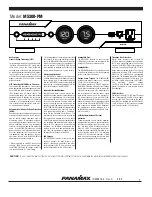
2. APPLICATION
GEK-106243E
DTP Digital Transformer Protection
2-1
2. APPLICATION
2.1 DESCRIPTION
The current transformer ratios and relay taps must be selected to obtain the maximum sensitivity without risking
relay measurement overflow, thermal overload of the relay or current transformers. Due to the low level of load
presented by the relay, which has a permanent thermal capacity of 4 times In, and a transient capacity of 100 x In,
it is very improbable to cause an overload this way.
Therefore, the current transformer ratios in the various windings of the power transformer should be selected with
the following points in mind:
•
The highest sensitivity is obtained by selecting the lowest relay tap and the lowest CT ratio. However, the
lowest CT ratio and the lowest relay tap may not be compatible with some of the following restrictions. Where
a choice is available of increasing either the CT ratio or the relay tap, it is preferable to increase the CT ratio
instead of the relay tap. Since the relay burden is usually smaller than the lead burden, increasing the CT ratio
tends to improve the relative performance of the CTs. This is a result of reducing the maximum secondary
fault current and increasing the accuracy of the CTs.
•
The CT secondary current must not exceed the continuous thermal rating of the CT secondary winding.
•
The relay current corresponding to the maximum kVA (on a forced-cooled basis) of the power transformer
must not exceed 4 times the nominal current rating of the DTP relay (5 A or 1 A), which is the continuous
thermal capacity of the DTP relay.
•
The CT ratios must be high enough so that the secondary currents will not damage the relay under maximum
internal fault conditions. The DTP relay can withstand 100xIn for 1 second, nevertheless, the dynamic limit
current is sensibly higher.
•
The relay current corresponding to rated kVA of the power transformer (on a self cooled basis) must not
exceed the relay tap value selected. Otherwise magnetizing inrush current might operate the backup
instantaneous function (87B). If the power transformer does not have a self-cooled rating, the user should
contact the manufacturer for the “equivalent self-cooled rating”.
•
The DTP relay’s backup instantaneous function (87B) can be set to operate for differential currents from 4 to
12 times the selected relay tap. If in-service experience results in instantaneous function operation during
magnetizing inrush conditions, such operation can be avoided by changing the setting to a value greater than
8.
•
The CT, on its full-ratio or the tap chosen, must be able to supply the relay with a current of 8 times the
selected tap, with an error of less than 20% of the total current. If the current transformers produce an error of
greater than 20% at less than 8 times tap value, the harmonic content of the secondary current may be
sufficient to prevent the differential protection from operating. Since the backup instantaneous function is
activated by the fundamental component and is not affected by the harmonic content of the differential
current, the instantaneous function will operate to produce a relay trip even if appreciable CT saturation
occurs for an internal fault that produces current above the instantaneous function’s recommended pickup
setting of 8 times tap.
•
The CT ratios must be selected to provide balanced secondary currents for the case of an external fault.
Since it is rarely possible to match the secondary currents exactly by selection of CT ratios, ratio matching
taps are provided in the relay to match the secondary currents within very narrow margins. When the power
transformer is equipped with Load Tap Changing (LTC) a close match cannot be obtained at all points of the
ratio-changing range. In this case, the secondary currents are matched at the middle of the range and the
relay’s percentage restraint is relied upon to prevent relay operation on the unbalanced current when the LTC
is at the ends of the range.
Summary of Contents for DTP-B
Page 23: ...3 OPERATING PRINCIPLES 3 6 DTP B Digital Transformer Protection GEK 106243E ...
Page 53: ...10 INSTALLATION AND MAINTENANCE 10 2 DTP B Digital Transformer Protection GEK 106243E ...
Page 68: ...12 FIGURES GEK 106243E DTP Digital Transformer Protection 12 3 Figure 3 RS 232 Connection ...
Page 69: ...12 FIGURES 12 4 DTP B Digital Transformer Protection GEK 106243E Figure 4 Dimensions Diagram ...
Page 70: ...12 FIGURES GEK 106243E DTP Digital Transformer Protection 12 5 Figure 5 Front View ...







































